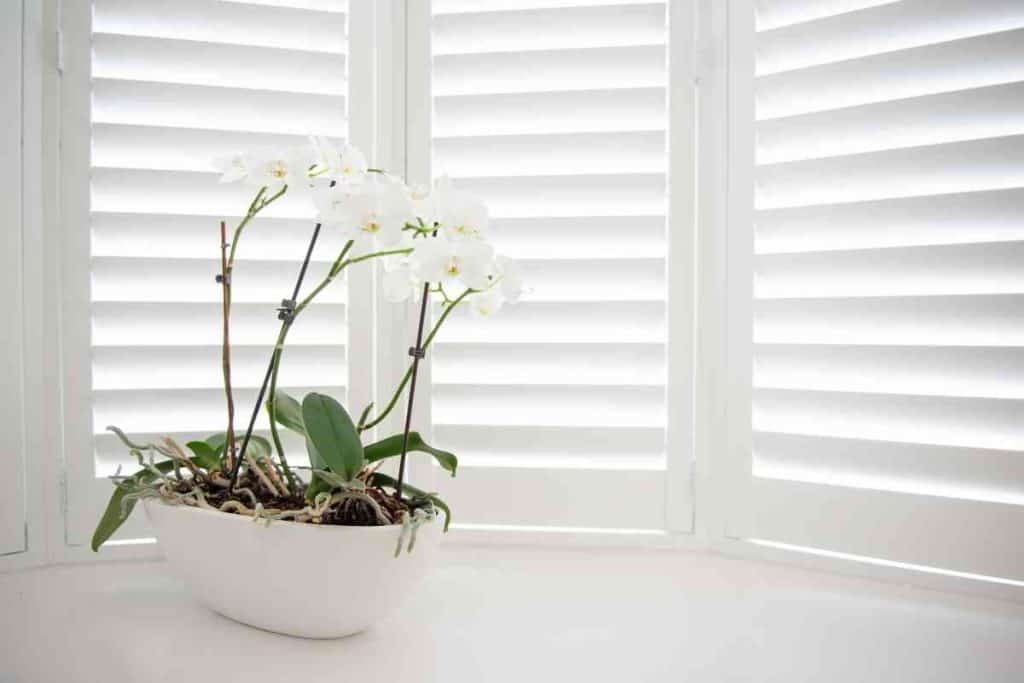Orchid is a popular houseplant, especially as it is easy to grow and looks quite attractive when you keep it in the right corner of your home. It can grow in different conditions and possesses a variety of colors.
Unfortunately, orchid leaves turning yellow is a common occurrence and could mean that your plant is not getting the help it needs.
Yellowing of orchid leaves is one of the most common problems of indoor orchid plants and can be frustrating. Sometimes, yellowing and falling off of leaves are a natural occurrence. But once the younger and newer leaves start turning yellow, it could be a dangerous sign.
Orchid leaves turning yellow could be a resultant effect of dying roots. It can no longer distribute water or nutrients all over the orchid, thus causing the orchid leaves to turn yellow as a sign of stress from overwatering or lack of it. Temperatures colder than 55°F and sunburn could also cause the yellowing of orchid leaves.
Table of Contents
What Is an Orchid?

Originated from the Orchidaceae family, the orchid is any of the 1,000 species of the Asparagales group of monocotyledonous blooming plants, including the asparagus and iris families. It is a stunning flowering plant that is now popularly distributed worldwide, particularly in wet tropical regions.
The term ‘orchid’ is coined from the Greek word ‘orchis,’ which means testicle due to the shape of the root tubers in several of its genus-species Orchis. It is a non-woody perennial plant and is terrestrial or grown as epiphytic herbs in all continents apart from the Antarctica regions.
The varieties that always attach to other plants are vine-like and possess spongy root covering, known as the velamen, which receives water from the surrounding air. A good number of the orchid species produce their food, while others feed on rotten organic material, hence are called saprophytes.
Why Is Your Orchid Leaves Turning Yellow?
This article is a must-read if you wonder why your orchid leaves are turning yellow.
One of the most common reasons for orchid leaves turning yellow is overwatering. When you overwater, the roots become flooded, cutting off from the air, and stop getting water and nutrients. As a result, not only will the orchid leaves turn yellow, they will lose their elasticity and cause the root system to decrease.
It is, therefore, essential to transplant the plant into a new substrate and water not over once a week. There are other causes of orchid leaves turning yellow.
Read down to find out, as we also give you some possible treatments to these orchid problems!
1. A Sign of the Orchid’s Natural Life Cycle
When there is a natural death of mature foliage on the orchid plant, it could cause its leaves to turn yellow. In this case, you have nothing to worry about, as it is only a sign of its natural life cycle. Whenever the orchid starts developing fresh leaves or new flower spikes, the lowermost set of leaves starts yellowing.
They die back and start falling off the plant in the long run. Orchids go through this process because they focus on new growth, seeing the lower leaves as unimportant. Unfortunately, this makes them cut off the water supply to the leaves, and they tend to drop off in the long run.
You will know if the yellowing is expected when one or two leaves underneath your plant turn yellow. The leaves will continue to yellow in the long run and then die off the plant. The orchid seals off these leaves from the other parts of the plant. Mind you, don’t detach them from the plant yourself.
2. Excessive Direct Sunlight
In their native environment, orchids significantly thrive in indirect sunlight under cover of trees. However, they are not accustomed to direct sunlight; therefore, placing them in an excessive sunlight area risk turning their leaves yellow. Almost every plant requires light, but indirect sunlight is the best condition for an orchid plant.
If faced with the excessive direct heat of the sun, it will undoubtedly cause its leaves to yellow and fade. However, too much sun can also lead to scorch marks, cracks in the leaves, and even burnt leaf edges. Therefore, it would be best to avoid an area that receives too much sunlight.
Possible Remedies
When you plant the orchid indoors, you can place it close to north or east-facing windows in the summer, when the sunlight is hottest. Then, you can set it near a south or east-facing window when the sun is less scorching during the winter.
But you have to ensure you don’t face the plant towards the south window in the summer, as it will be very disastrous to the orchid. However, since we can’t change our window locations, you can apply a sheer curtain or move the plant slightly away from the window if the sun is too hot.
3. Exposure to Low or High Temperatures

Orchids prefer moderate temperatures of about 60 to 80°F. These are the average temperature in the home of several homeowners; hence it is a perfect prospect—any temperature below 60°F or over 80°F, risk suffering from too much stress.
Maybe, you discovered the increasing yellowing of leaves and leaf drops. However, temperature stress can also result in the browning or blackening of leaves or even death of the plant.
Possible Remedies
Out of every possible cause of the yellowing of leaves of orchid plants, inadequate temperatures are one of the most straightforward to address. Quickly find a thermometer and double-check that your chosen area is around the required temperature range.
At times, windows could be prone to changes in temperatures. For example, during the summer, with direct sunlight, your window could be located in or around an oven, and if temperatures become cold outside, the window tends to become chilled.
4. Overwatering
One of the most common reasons for orchid leaves turning yellow is overwatering. When you overwater, the roots become flooded, cutting off the air, and stopping getting water and nutrients from the soil.
As a result, not only will the orchid leaves turn yellow, they will lose their elasticity and cause the root system to decrease. It is, therefore, essential to transplant the plant into a new substrate and water not over once a week.
Possible Remedies
We have come to discover that most indoor gardeners often overwater their plants. Watering is the most essential and challenging care routine for most plants, including orchids; hence, watering should be your key focus. Do not overwater orchids.
That is not to say that it doesn’t need water. But, of course, it requires a tiny amount of water. But you have to insert your fingers into the potting medium to check for dryness before watering your orchid. If it is not dried yet, wait for about a day or two before watering. But, if it is dry, you can water it as required.
5. A Sudden Change in the Environment
Moving your orchid from its original position or changing its environment will stress the plant, causing its leaves or flowers to fall off.
Some yellow leaves are a more severe resultant effect of stress in orchids. This stress comes when you keep moving the plant from one room to another, especially when relocating.
Possible Remedies
If you discover that your plant has started turning yellow leaves immediately after you brought it home from the store, then there is nothing to worry about, as there is nothing you can do about it. Just ensure you choose a perfect area for your new orchid, and everything will fall back in place.
It would be somewhat difficult to stop this kind of problem, and all you could do in this case is find the best climate for the plant. Most times, we couldn’t help but think that stores would help minimize plant stress, but we also know that it might not happen that way.
6. Over-fertilizing
Over-fertilization is another tricky aspect of orchid care because it is easy for gardeners to apply too much fertilizer. However, excessive fertilizer gives the plants additional nutrients, like calcium, manganese, copper, or zinc.
Even though the plant may require access to additional nutrients in the soil, the amount tends to be too much, thus preventing your orchids from absorbing iron.
A symptom of iron deficiency in orchids includes leaves turning yellow, otherwise known as chlorosis. Therefore, beware of adding too much, as it can be problematic.
Possible Remedies
The bad thing about feeding your orchids with excessive fertilizer is that you will hardly withdraw it. The only way to solve this problem is by learning how to feed your plants best. Orchid species are not heavy feeders; therefore, you mustn’t provide them too often, and diluting is required.
In other words, reduce the strength by ¼ to ½ as compared to the fertilizer you use with other indoor plants. Another alternative is to get recommended fertilizer orchids and carefully do as directed.
Again, ensure you’re not frequently watering with a water-soluble fertilizer. It would help if you alternate, thus giving it time to drain out nutrient salts in potting soil.
Anytime you purchase an orchid, you will more often discover that they are already in full flowering, which means there’s no need to fertilize. However, once the flowers drop, you can begin your fertilizing routine, as it helps to encourage plant growth and new bloom development.
7. Nutrient Deficiency
Failure to provide your orchid plants with fertilizer will result in nutrient deficiency, a significant cause of yellow leaves. You may not know that your plants require fertilizer, should the potting medium contain enough nutrients. Even if it does, it might not be sufficient to last long.
Immediately after the nutrient remnants exhaust, your orchid will show nutrient deficiency symptoms, except if you add fertilizer. There are manganese, zinc, iron, and nitrogen deficiencies in orchids. They are all needed for healthy growth and need fertilizer.
Possible Remedies
You can quickly solve this issue. You only need to begin the application of fertilizer all other week or whatever you are directed on the fertilizer you purchased.
8. Exposure to Hard Water or Chemicals

You should be careful with the type of tap water you use for the watering or feeding of your orchid, as it also contributes to or even causes its leaves to turn yellow.
In addition, there are places with hard water or water that is over-treated with chlorine. Your plant might find it hard to process these chemicals in such cases, thus causing yellow tips.
Hard water features a high amount of calcium and magnesium that is dangerous to the orchid’s ability to absorb vital micronutrients, resulting in nutrient deficiencies and leaf issues.
Possible Remedies
If you find it challenging to know what causes your plant’s leaves to turn yellow, you can employ the services of a local water inspection service and inquire for copies of the water testing results. They will show you every chemical they’ve detected in the most recent test.
If it shows there is an issue, you’ll be presented with three alternative solutions:
- Using rainwater
- Buying a house filtering system
- Purchasing filtered water for your orchids
The use of rainwater is the cheapest option, although, in some states, it is not a legal practice; hence, before you apply this option, first check if your state laws allow it.
9. An Infection
Another reason for orchid leaves turning yellow is infection or disease. Significantly, infections or diseases often cause yellow spots and patches on the leaves instead of the general yellowing of a whole leaf.
Three common diseases of orchid plants include root rot, fungal leaf spot, and bacterial brown spot.
Possible Remedies
Orchid plants do not like hot and humid areas, as they can be vulnerable to any of the above infections in such conditions. And as they become worse, the broad leaves yellowing, which is a symptom of stress the orchids are going through.
Therefore, the ideal solution is to eliminate every infected part of the leaves or even the whole leaves using sterile scissors. Once removed, utilize an antibacterial spray or fungicide to stop other plant parts from contracting the fungus spores.
You may also want to read:
- Lemon Tree Leaves Turning Yellow
- Why is Orchid Plant Dying?
- Why is My Succulent Dying?
- Why Is My Cactus Turning Brown? (How To Save It)




